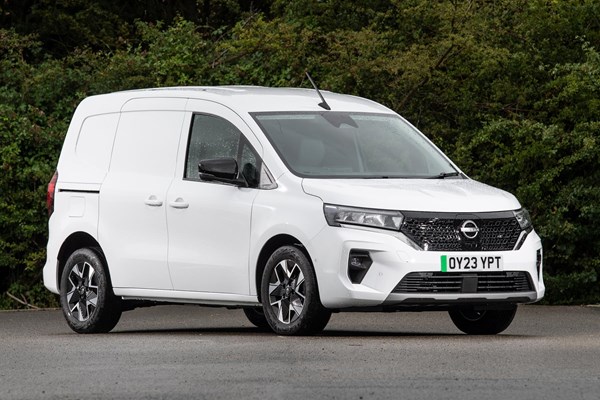Nissan Townstar EV (2023) van review
Low(-ish) payload, but otherwise a cracking value electric van
PROS
- Good value for money
- Better electric range than rivals
- Class-leading 1,500kg towing capacity
- Loads of driver assistance tech available
- 11kW AC charging as standard
CONS
- Base-model only has a 600kg payload
- Maximum range is still under 200 miles
- UK vans miss out on clever folding bulkhead
- Stellantis vans offer 100kW DC rapid charging
- Only one battery option
Summary
The Nissan Townstar EV has quite the reputation to uphold. It’s the replacement for Nissan’s popular e-NV200 panel van, which set the template for small electric vans when it was introduced in 2014 and regularly topped the European sales charts until it was axed in 2021.
Unlike the e-NV200 (which was a standalone van cobbled together from Nissan Leaf components), the Townstar is a collaborative effort that shares its underpinnings with the latest Renault Kangoo and Mercedes Citan. This has allowed Nissan to take advantage of the economies of scale and compete on price with its closest rivals from Stellantis.
That’s important. Stellantis has a tight grip on the small electric van market in Europe but, because it’s such a value-driven segment, any manufacturer looking to challenge the supergroup simply needs to make a good product at a cheaper price. And Nissan has done a great job at that.
At the time of writing, the most basic Nissan Townstar Visia was priced from £32,445 not including VAT or the government’s £2,500 plug-in van grant (PiVG). That makes it around £1,100 cheaper than the entry-level Peugeot e-Partner. It's even roughly £300 less than the most basic Citroen e-Berlingo.

That’s a significant saving – and it gets better because you get more for your money by opting for the Townstar. Compared to the e-Partner and e-Berlingo, the Townstar has a longer range of 183 miles (compared to 171 miles for the Stellantis vans), faster 11kW AC charging as standard and a longer five-year vehicle warranty. The short wheelbase Townstar also has the same 3.3 cubic metre cargo bay as the smallest Stellantis vans, but it offers double the towing capacity at 1,500kg.
There’s a flipside, though. The most basic Townstar has a lower payload of just 600kg, while the entry-level Stellantis vans can carry 800kg. However, you can get around that by shelling out an extra £1,500 for the long-wheelbase Townstar, which can also carry 800kg.
If you think that sounds like a con, just look at it this way – you’re getting the same payload capacity plus an extra cubic metre of storage space for a mere £500 over the most basic short wheelbase Peugeot e-Partner. If that isn’t good value, we don’t know what is.
Nissan Townstar EV versions and trim levels
You have plenty of choice here. The Townstar EV is available as a short wheelbase van, a long wheelbase van and a long wheelbase crew van. You also have a choice of four trim-levels called Visia, Acenta, Tekna and Tekna+, echoing that of Nissan’s passenger car range.
The most basic Townstar Visia comes with 16-inch steel wheels, LED headlights, electrically adjustable and heated door mirrors, remote central locking with deadlocks and a tyre pressure monitoring system. You also get a range of tie-down points in the rear and an airbag for the driver.
Acenta grade vans feature LED fog lights, automatic climate control, cruise control, rear parking sensors and an 8.0-inch infotainment system with Apple CarPlay and Android Auto. The van’s charging system is given a boost, too, with a faster 22kW AC on-board charger and support for up to 80kW DC rapid charging speeds at public charging points.
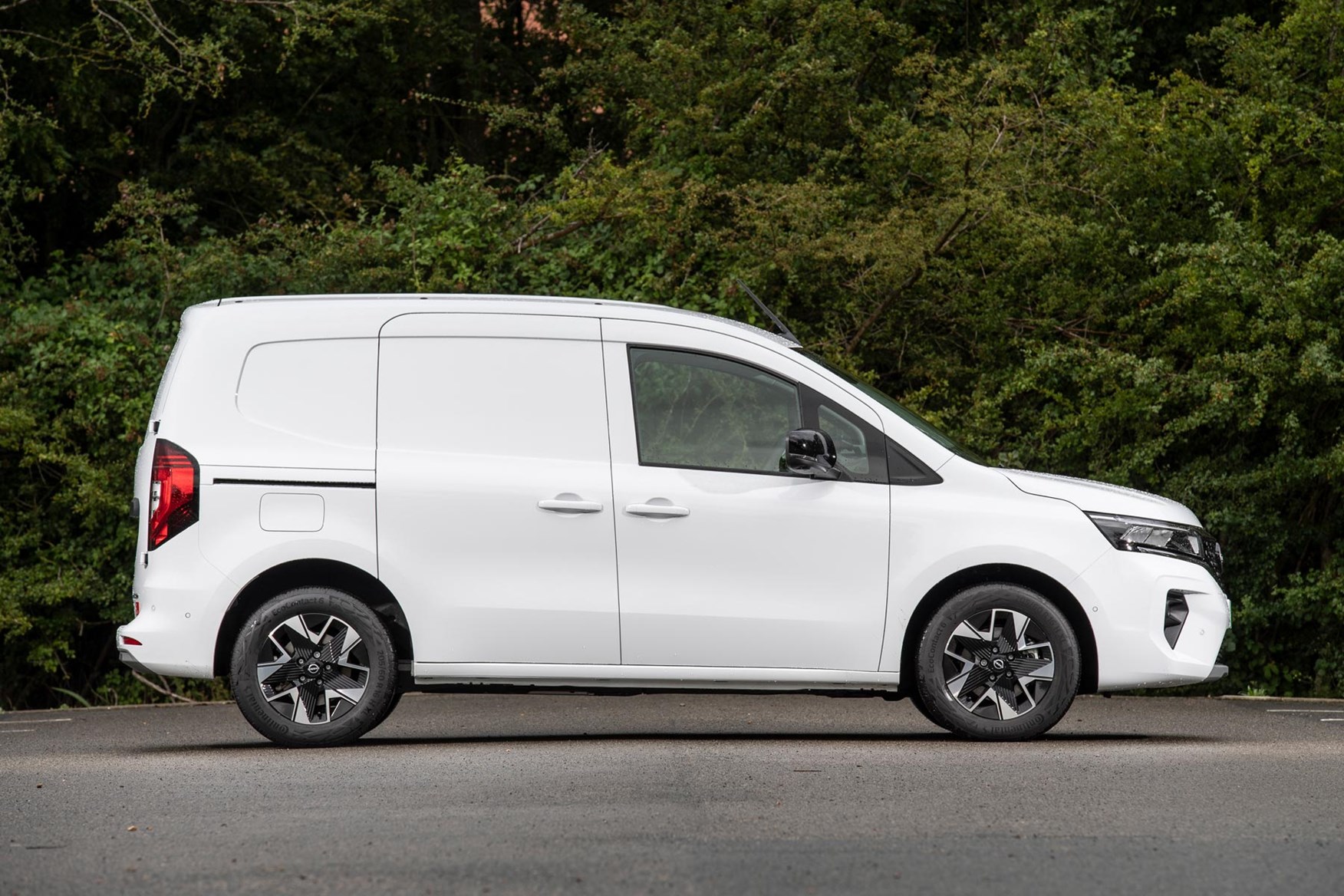
Tekna models get body-coloured replacements for the front bumper, door handles and door trims, as well as keyless go, all-round parking sensors and a rear-view parking camera. Nissan also throws in a smartphone holder and a built in sat-nav for the van’s 8.0-inch touchscreen.
The flagship Tekna+ model gets all the bells and whistles. We’re talking 16-inch diamond cut alloy wheels, a heated leather steering wheel, a 10-inch digital gauge cluster and a host of driver assistance technology, including an automated parking function and Nissan’s semi-autonomous ProPilot system, which combines intelligent adaptive cruise control with lane-keeping assist to take some of the strain off the driver on the motorway.
What’s powering the Nissan Townstar EV?
Like the Renault Kangoo E-Tech and Mercedes e-Citan, the Nissan Townstar EV features a 45kWh battery pack and an electric motor mounted on the front axle. The system produces 122hp and 245Nm of torque, which serves up a 0–60mph time of 14 seconds and a top speed of 84mph. That means it’s slower from a standstill than the Stellantis vans, but 3mph faster at the top end.
In the Townstar’s case, though, the biggest benefit of electric power isn’t the performance – it’s the refinement. We’ve driven the diesel and petrol versions of its sister vans and, while they’re very refined for commercial vehicles, they can’t match the serenity of the electric model.
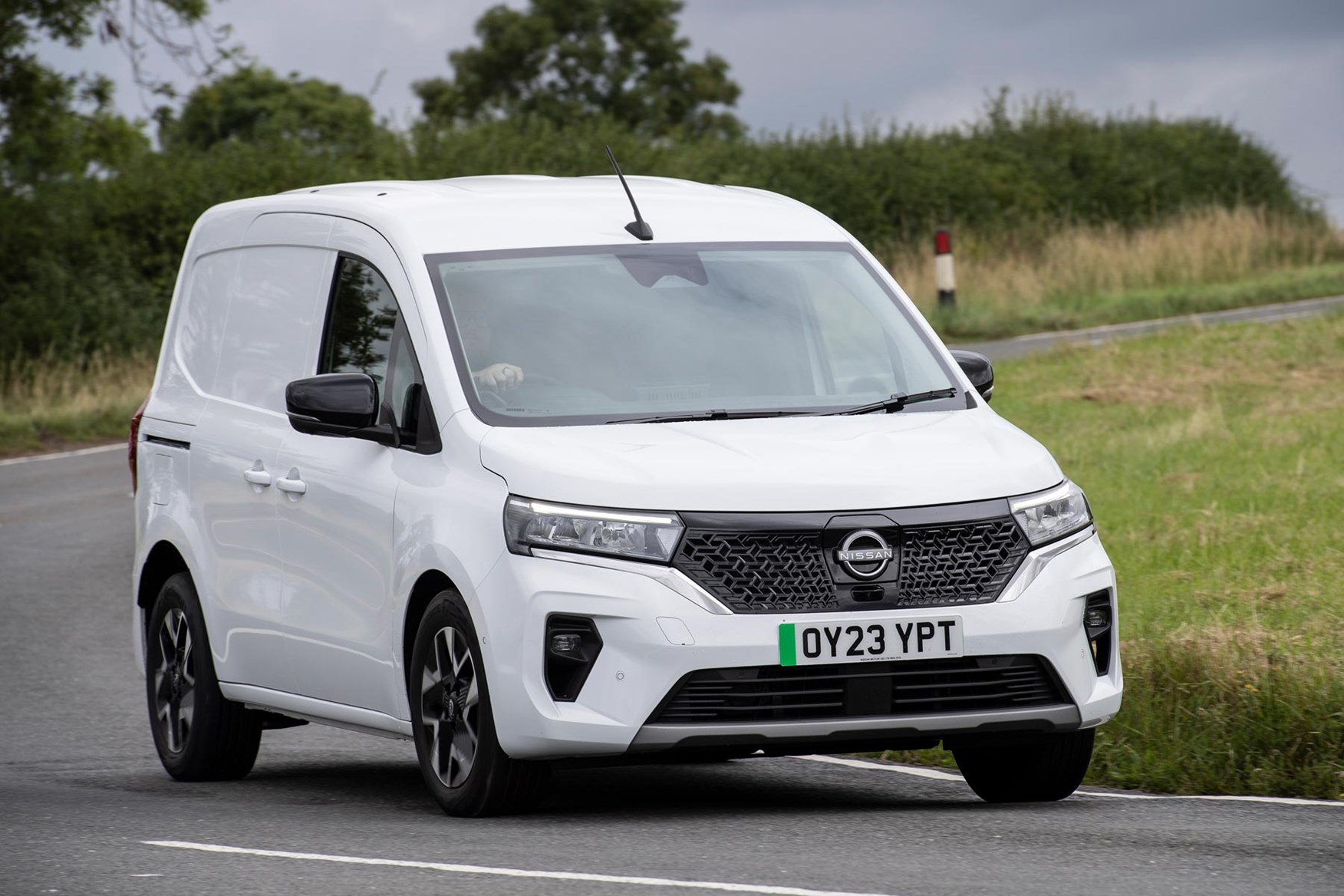
The electric motor is almost silent and the added weight of the battery pack low down in the van’s chassis means it rides well, even when you’re not carrying any cargo or tools. Nissan has made merry with the sound deadening, too, so the body doesn’t rattle like an allotment shed when you drive over potholes. It’s like driving a passenger car from 10 years ago, which is high praise for a van.
Verdict: is the 2023 Nissan Townstar EV any good?
We think the Townstar makes more sense than the Renault Kangoo E-Tech and Mercedes Citan, primarily because it’s more affordable. It’s also more practical than its rivals in lots of areas, but it’s a balancing act – and you’ll need to make some sacrifices to gain the Townstar’s benefits.
The cheapest Townstar undercuts popular electric vans like the Peugeot e-Partner and Citroen e-Berlingo on price, but it surrenders some payload weight to achieve that. And, while its five-year warranty is good, it can’t match the impressive 10-year warranty of the Toyota Proace City Electric. The Proace is also around £500 cheaper so, if all you need is a small, affordable and reliable electric van with a good payload, these points might be enough for you to discount the Townstar entirely.
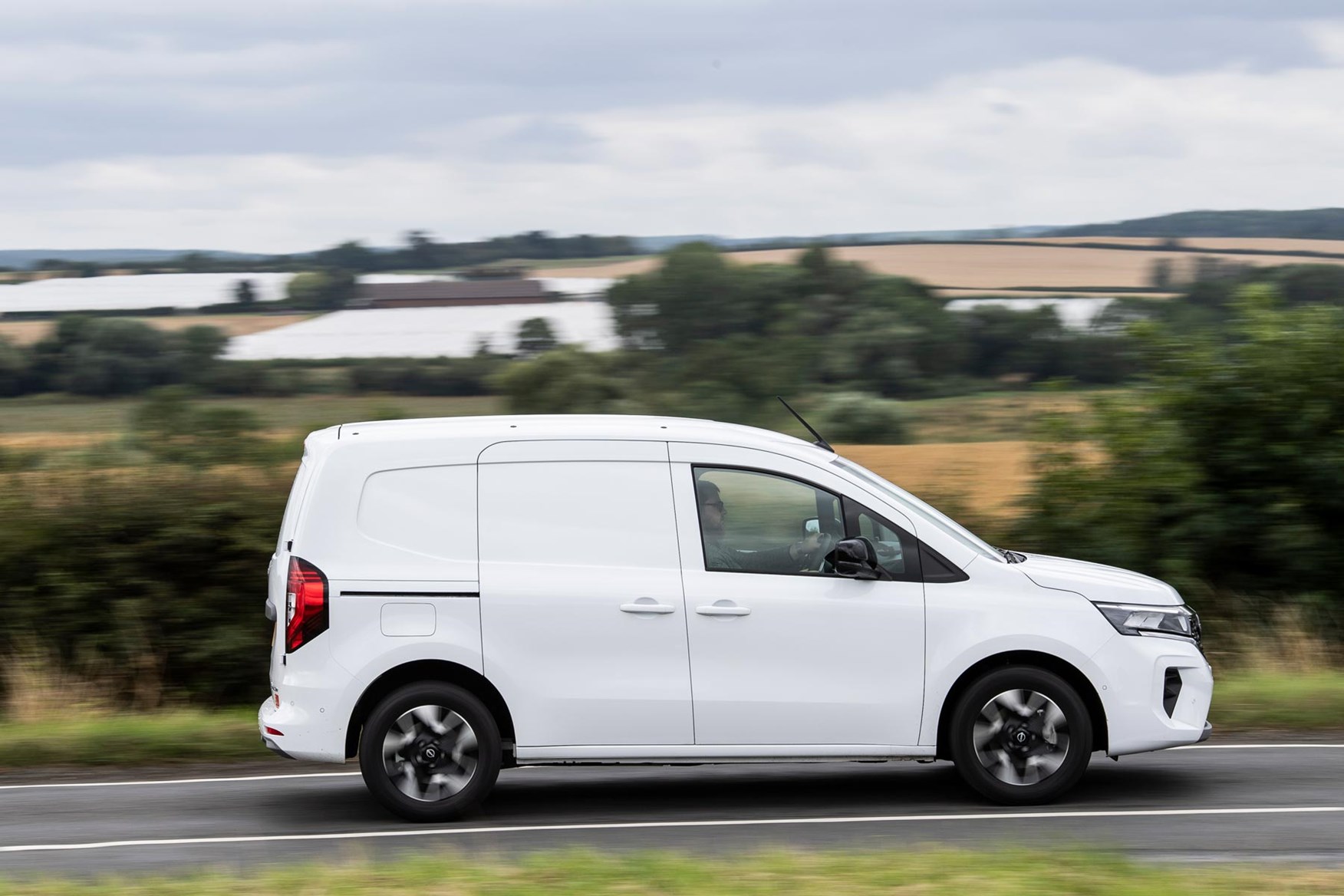
But remember that the Townstar has the highest towing capacity of any van in its class and it has a very comfortable ride, even when the rear isn’t bursting with clobber. So, deciding whether the Townstar is right for you all depends on what you plan on doing with it. For example, if you’re a landscaper with a trailer full of power tools to cart around, or if you spend a lot of time on the road as a delivery driver, you’ll probably find it more useful than its competitors.
It's up there with the best in the class and, in lots of cases, it beats the new benchmarks for electric commercial vehicles set by the Stellantis group. The Townstar is certainly a worthy successor to the e-NV200.
Skip to our full verdict on...
- Refined and quiet cabin
- Silent and punchy electric motor
- Surprisingly comfortable, even when empty
The Nissan Townstar drives much better than the commercial vehicles from a decade ago. It can’t match the Ford Transit for outright driver engagement, but it’s certainly better than the Peugeot e-Partner and Citroen e-Berlingo. And, because it’s based on the same CMF-CD platform as the Nissan Qashqai and Renault Austral, it’s surprisingly car-like to drive.
We’ve spent time in the Townstar both in central Paris and on a mixture of UK roads. In both scenarios, we were impressed by its ride in particular, both at low speeds and on the motorway. It’s surprisingly supple for a van and the rear end doesn’t jump over speed bumps even when you’re not carrying anything. We reckon this competence is down to the heavy battery pack mounted under the floor of the cabin, which helps to keep the chassis settled over bumps and potholes.
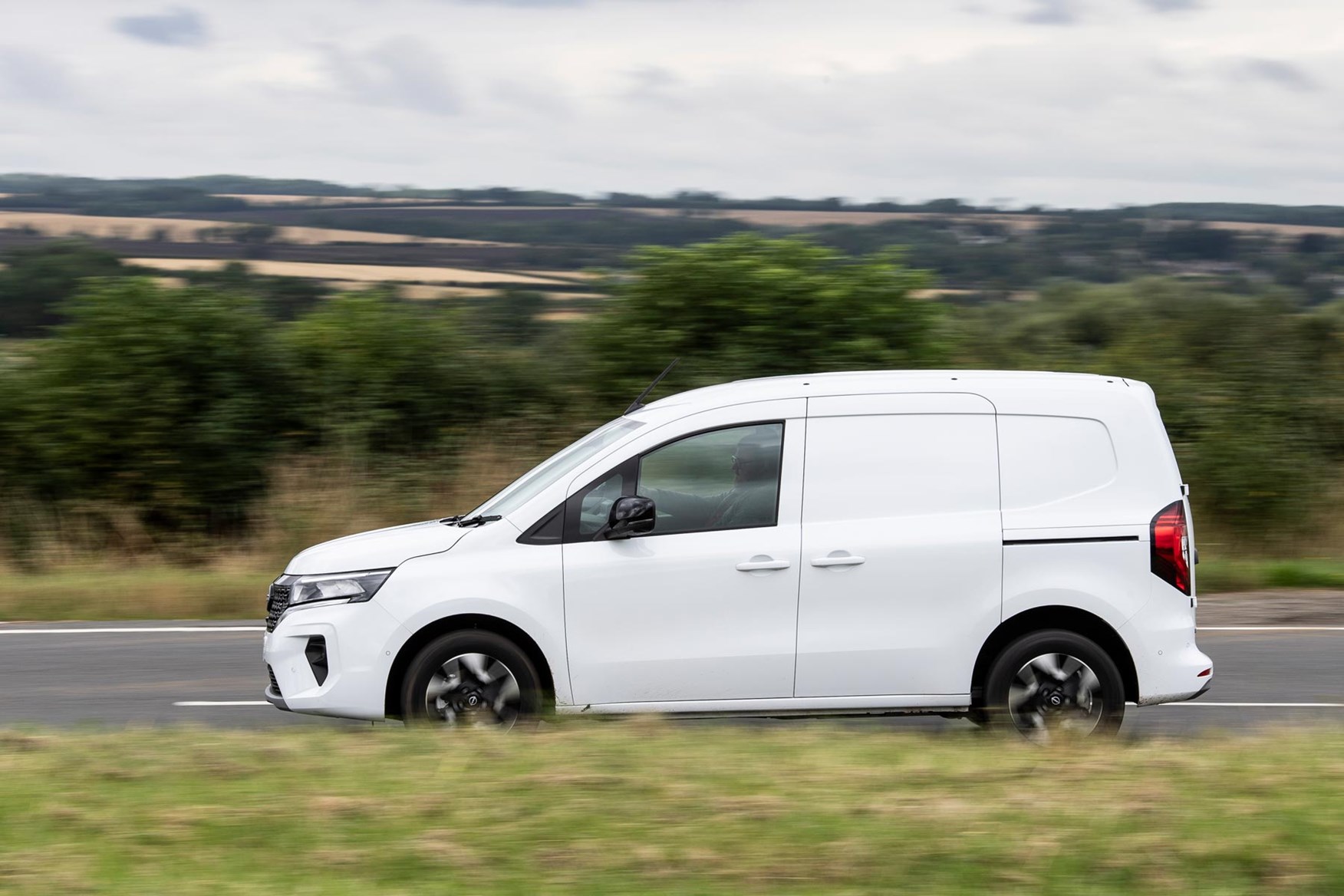
We like the steering, too. It’s direct and reasonably lightweight, which makes it doddle to thread the Townstar through chaotic traffic. It’s also only 200mm longer and 25mm wider than the Nissan Qashqai, so it’s easy to place on the road – and the wide door mirrors make it easy to spot kamikaze moped riders and enraged taxi drivers.
It's got a town mode for the steering, too, which makes it even easier to spin the wheel around to get in and out of tight spots. To be honest, we regularly forgot to use it on plenty of occasions where we could have pressed the button, though. It isn't as if the steering is heavy, so there isn't really a moment when you are going hand-over-hand as you try and force the van out of a parking space.
The electric motor has enough performance to exploit gaps in the traffic but it isn’t powerful enough to knock your cargo over, which suits the Townstar’s relaxed nature well. Despite being most at home around town, it is perfectly comfortable on the motorway, too. It offers good refinement when cruising and progressive acceleration when overtaking.
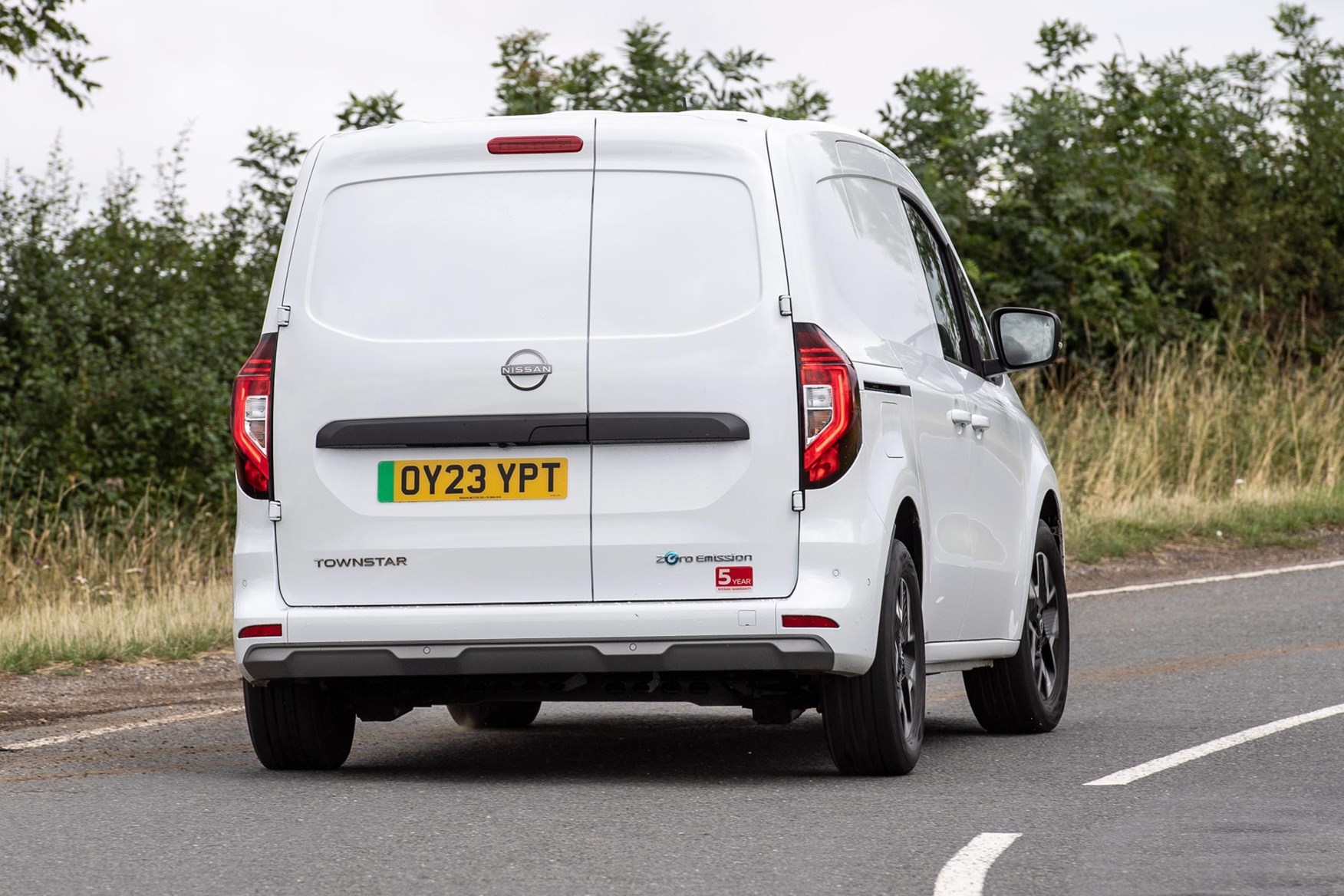
The brake-regeneration modes are set by knocking the gear lever to the right and then moving it up and down, much as you would change gears if it was a conventional automatic. You can't put it into a one-pedal mode, as you can with other electric Nissans like the Leaf, as the highest setting merely slows you down rather than taking you all the way to a standstill, but it does provide a good variation between the three.
The adaptive cruise control ran into a little issue when we tested the Townstar in some wet and dirty conditions. The forward-facing radar system got dirty enough that it wasn't able to pick out the cars in front, which meant it prevented the use of cruise control full stop. The ability to set a manual speed without the adaptive element would be handy.
However, when the radar was clean, it also provided a handy trick, as it is able to show how far ahead the car in front is in seconds. Some drivers won't see much benefit in it, while it may assist others by putting their tailgating into basic numbers.
- Comfortable seats
- Good infotainment system
- Plenty of tech on top trim
The Townstar’s interior is better finished than the Peugeot e-Partner and Citroen e-Berlingo’s. The plastics are of a slightly better quality and the seats are much more comfortable, offering much more lumbar support. The cabin is also far less boomy, thanks in equal measure to the sound deadening up front and the solid bulkhead fitted to UK models.
There’s a flipside to this, though, because UK buyers miss out on some practical solutions offered to buyers on the continent. European drivers can have a clever vertical split-folding mesh bulkhead and folding front passenger seat that allows you to transport longer items (like lengths of copper pipe or timber) inside the van. We also don’t get the European van’s enormous glovebox.
Despite these oversights, the Townstar’s cabin is still quite practical. There’s a big overhead storage tray, a well-sized centre console and a handy lidded storage box above the instrument binnacle which is great for hiding valuables. The door bins can also accommodate litre-sized water bottles.
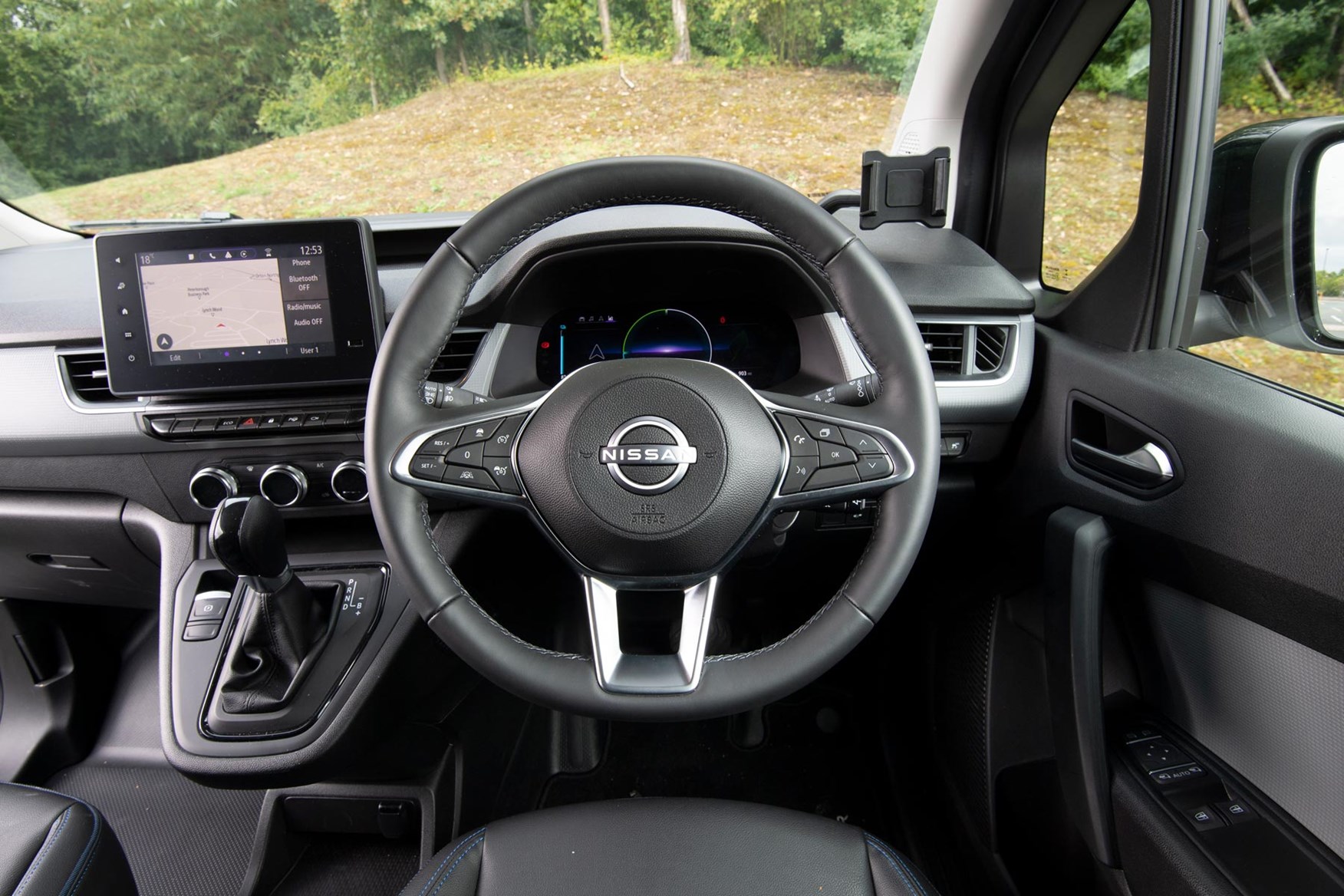
We like the infotainment system, too. The 8.0-inch unit fitted to Acenta grade models and up looks sharp and responds quickly – and it’s easy to read in bright sunlight. Nissan’s built-in sat-nav system is intelligent, too, but Apple CarPlay and Android Auto work perfectly well, so don’t feel like you need to spend the extra cash on the Tekna model.
There’s plenty of equipment on the range-topping Tekna+ variant, although it is quite expensive, costing more than £37,000. Stand-out features include a self-parking system and a 360-degree camera, both of which are clever – but they’re not without their faults.
The self-parking system is a little temperamental. If the sensors are even slightly dirty, they’ll struggle to recognise spaces and will refuse to park the van. You can’t rely on the camera system when parking, either – the fisheye lenses distort the distances slightly and make objects appear further away than they are.
- More expensive than petrol model
- Longer official range than key rivals
- Five-year/100,000-mile warranty
The Townstar EV is powered by a 45kWh battery that offers a claimed WLTP range of 183 miles. This is slightly more than the 171 miles claimed by the Peugeot e-Partner and Citroen e-Berlingo, despite the fact those vans feature larger 50kWh batteries.
We haven’t yet spent enough time in the Townstar EV to determine how accurate that range figure is under real world conditions, but Nissan seems confident in its ability. The firm even touts that, if you’re only pottering the van around at low speeds, it can drive for up to 269 miles.
For now, all we’ll say is that the e-Partner and e-Berlingo can’t achieve their claimed range figures. Drive down the motorway with any kind of payload in the back and you’ll be doing well to manage 100 miles before stopping to charge. We’re interested to see whether the Townstar can do better.
One thing to bear in mind if you’re considering the Townstar EV is the price. It’s a little cheaper than its key rivals – but it’s still almost £35,000. That’s an awful lot of money, especially when you consider that the petrol-powered Townstar starts from a shade under £24,000 including VAT.
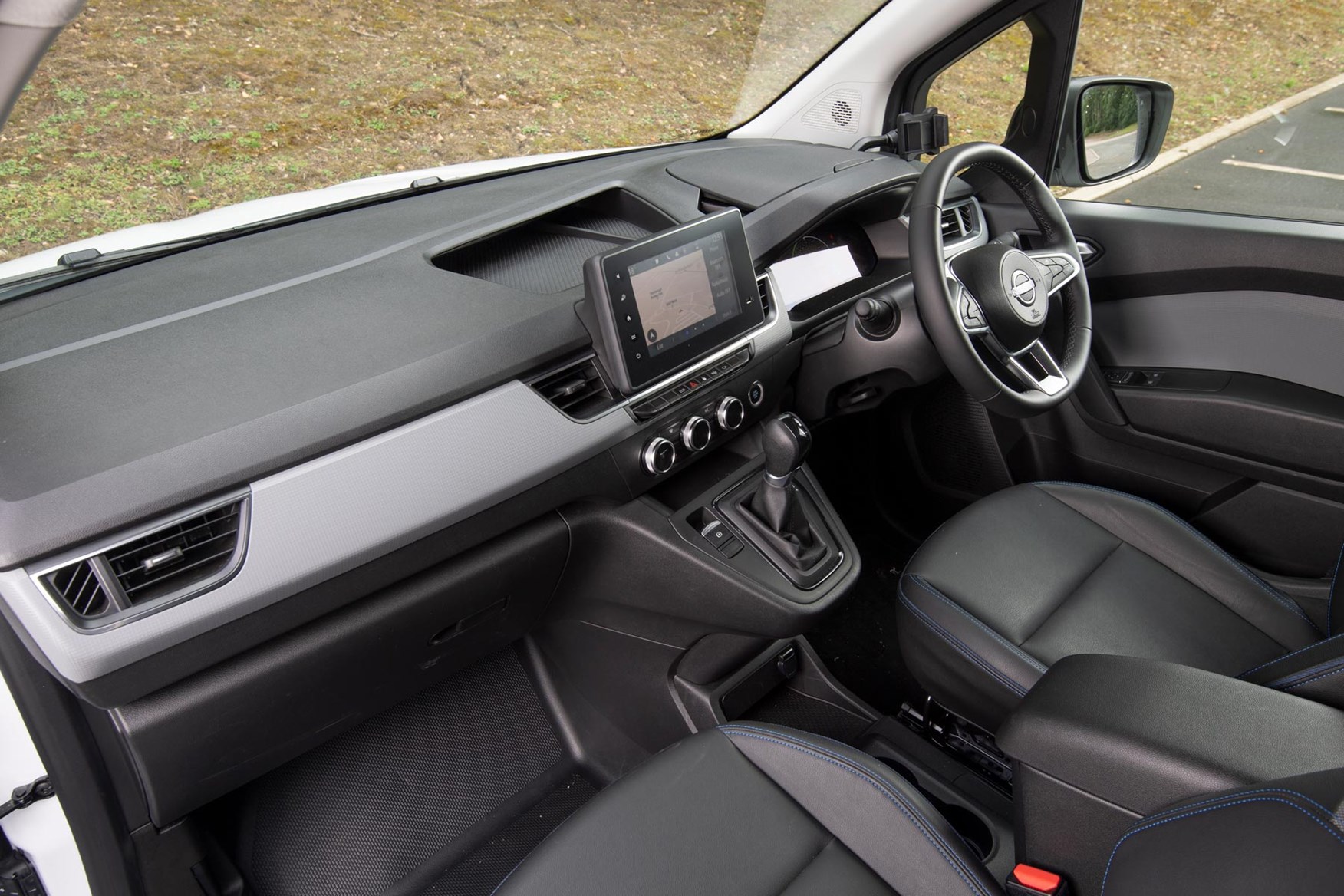
The price gap between petrol and electricity has narrowed over the last year, too, meaning EVs aren’t as cheap to fuel as they once were. If you’re a city-dwelling tradie that regularly charges up at public DC rapid chargers, you might end up paying the same amount per mile as the petrol model.
The Townstar has a competitive charging setup, though. The most basic van comes with an 11kW AC on-board charger as standard which can completely recharge its battery in five hours. The same 11kW charger is an optional extra on the Peugeot e-Partner and Citroen e-Berlingo.
Middling Acenta grade vans gain an even faster 22kW AC on-board charger (which you can’t get on the Stellantis vans) and support for 80kW DC rapid charging. Granted the latter system is slower than the 100kW DC system fitted to the Peugeot and Citroen, but the Townstar EV can still take on 90 miles of range in 25 minutes. That should be enough for your commute to the job and back.
Nissan Townstar EV warranty
Nissan has tried to steal a march on the competition here. The Townstar comes with a five-year/ 100,000-mile vehicle warranty, which is two years and 40,000-miles longer than the Peugeot e-Partner and Citroen e-Berlingo. The Townstar’s battery is also warrantied for eight years.
The only commercial vehicle in this segment that can do better is the Toyota Proace City Electric. It’s pretty much identical to the Peugeot and Citroen but it comes with a 10-year warranty, providing you get it serviced at a registered Toyota dealership.
It’s still too early to provide an accurate assessment of the Townstar’s reliability. The EV model should be dependable, though, because there are far fewer moving parts than a traditional diesel van – and that means there are fewer things to go wrong.
You can also take comfort in the fact that the Townstar is based on proven technology. It’s built on the same platform as the Nissan Qashqai and Renault Austral SUVs, neither of which have poor reliability records.
- Four-star rating from Euro NCAP
- Lots of safety kit on top-spec model
- Standard driver’s airbag
When Euro NCAP crash-tested the Townstar in 2021, it awarded it a four-star safety rating. The van performed reasonably well across the board, but its pedestrian recognition system dragged its score down. The testers marked the performance of its autonomous emergency braking system as “adequate” when confronted with pedestrians, although it fared better with cyclists.
The entry-level Townstar Visia has a rather limited amount of safety technology. This includes a tyre pressure monitoring system, hill hold assist, a single airbag for the driver and LED headlights. The Acenta model is a more well-rounded package, adding cruise control, rear parking sensors and autonomous emergency braking.

If you splash out on the range-topping Townstar Tekna+, you’ll get a comparable level of safety equipment to most high-spec passenger cars. Features include lane departure warning, a traffic sign recognition system, all-round parking sensors and a blind-spot monitoring system.
Unlike the Peugeot e-Partner, you can’t specify the extra safety equipment on the entry-level version of the Townstar. If you want the tech, you’ll need to spend big on the flagship version. And it is a real shame, as ever, that it only comes with the one airbag as standard - there is no passenger version included.
Which Nissan Townstar EV is best for me?
That depends on what you plan on doing with it. If you’re carrying heavy payloads, avoid the short wheelbase model because it can only carry 600kg. You’ll be better served by the long wheelbase variant, as that can match the 800kg payload of the Peugeot e-Partner and Citroen e-Berlingo vans for only a marginal increase in price.
The Nissan Townstar is also great at towing. It can haul double the amount of its rivals from Stellantis (1,500kg), which makes it a good option for landscapers or builders with trailers full of power tools or heavy machinery.
Your biggest decision will be the trim-level, but we reckon most owners will be best served by the second rung on the Townstar’s trim-level ladder. The Acenta model has all the equipment you need to stay comfortable on your commute, including automatic climate control, cruise control and an 8.0-inch touchscreen with smartphone mirroring. And it starts from a very reasonable £31,495 once the government’s £2,500 plug-in van grant has been factored in.



